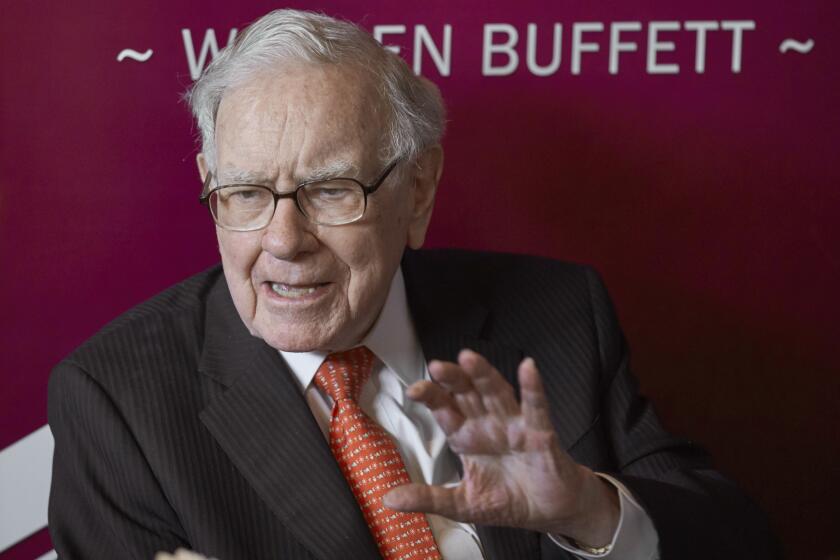‘V’ for ‘Victory’? There’s a Way to Beat Volatility
- Share via
On Wall Street, major market “trends” are becoming a lot like those proverbial little towns along rural freeways--you know, if you blink, you miss them.
IBM stock, the market’s locomotive just four weeks ago, lost 10% of its value on Tuesday after the firm forecast disastrous quarterly earnings.
Meanwhile, the bond market has been turned completely on its head since mid-February, and in the same period the dollar has defied virtually all forecasts and rocketed against most currencies.
In short, financial markets are exhibiting highly emotional swings that are the polar opposite of the steady one-way trends in place for most of the 1980s. What we’re seeing is the return of the “V”--as in volatility, and as in the “V” pattern on charts of stock, bond and dollar prices as they repeatedly plunge and then rebound.
The return of volatility isn’t likely to be a brief phenomenon, many experts warn. Instead, the markets may just be returning to their normal historical patterns of the 1960s and 1970s. Those were turbulent times, but they also were times of great opportunity.
While the general perception is that the 1980s were extraordinarily volatile, at least for stocks, that decade actually was only average in volatility for this century, says Walter Murphy, a Merrill Lynch & Co. analyst in New York who has done work on the subject. Investors’ perception of the ‘80s is skewed by the 1987 and 1989 crashes. But those computer-driven declines turned out to be brief aberrations in a long uptrend.
In contrast, the market swings of the past 15 months have been much more typical of the continually jumpy markets of the ‘60s and ‘70s. This time around, the economic recession and the Persian Gulf War certainly get some of the blame. Investors and traders are facing an extremely uncertain environment now, as they attempt to gauge whether the economy is recovering and whether inflation is going to be a continuing problem. Uncertainty breeds volatility.
But there is a more basic reason for the turn-on-a-dime moves that have dominated the stock market in particular since late in 1989. Many of the driving forces behind stocks’ steady rise for most of the 1980s died with the decade--for example, the heavy use of leverage, inflated asset values and strong foreign interest in U.S. stocks.
If you picked mediocre stocks in the ‘80s, they probably went up in spite of themselves. But now, the pressure on money managers to pick right is intense. That is leading many large investors to become trigger-happy as they try desperately to beat their peers in calling the market.
“There is tremendous pressure on money managers now,” says Peter Anderson, head of the IDS Advisory mutual fund firm in Minneapolis. Because clients often review managers’ results quarterly, “Everybody is in the performance racket,” he says. Though that been true for years, the pain of 1990’s bear market has worsened it.
The bond market’s crazed turnaround of the past six weeks may even better illustrate investors’ growing fear of failure. Interest rates have soared because investors assume that any economic recovery must be accompanied immediately by sharply higher rates--even though that has not been true historically. “Clearly, everyone in the bond market is trying to get a jump on everyone else, because they say ‘the only way we can win is to get that jump,’ ” Anderson says.
The danger is that investors are trying not only to anticipate the future but anticipate what others will anticipate as the future. It’s like a dog chasing his tail, faster and faster, until he collapses.
If you’re tempted to follow that Wall Street tail-chasing exercise, consider how well the Street did in its anticipation of IBM’s first-quarter earnings. Out of dozens of well-paid analysts who follow IBM, “none of them had a clue” about the company’s sharp drop in orders, says New York money manager Lazslo Birinyi. The IBM fiasco will only put more pressure on analysts to guess right, and on money managers to second-guess analysts. Probable result: even more volatility.
The irony in this return of volatility is that big investors’ attempt to make the markets more efficient--by reacting faster, and by increasingly trying to crystal-ball the future--may in fact make prices less efficient, as emotion overcomes logic. And therein lies the opportunity for those who can take a more rational, long-term view of investing.
Jeffrey Bronchick, associate research chief at L.A. money manager Campbell, Reed, Conner & Birdwell, says his $495-million-asset firm won’t alter the approach that has served it well for 30 years, no matter how markets swing in the ‘90s.
Bronchick says Campbell Reed’s managers do their own homework on stocks rather than rely on Wall Street; they pick strong companies that earn healthy returns on equity and have smart management, and they take the view that their holding period for the stocks might just be “forever” if the basic story doesn’t change.
It takes guts and discipline to stick with a long-term game plan in a market like this, Bronchick says. But the alternative is to join the increasingly panicked short-term traders, most of whom will probably just end up beating themselves at their own game.
Emotional Markets The jolting turns in the stock, bond and dollar markets over the past few weeks illustrate a return to volatility that is likely to persist in the 1990s, some analysts say. The Dow drops Dow Jones average (weekly close, except latest) interest rates jump 30-year T-bond yield and so does the dollar. German marks per dollar (weekly close, except latest)
More to Read
Inside the business of entertainment
The Wide Shot brings you news, analysis and insights on everything from streaming wars to production — and what it all means for the future.
You may occasionally receive promotional content from the Los Angeles Times.










